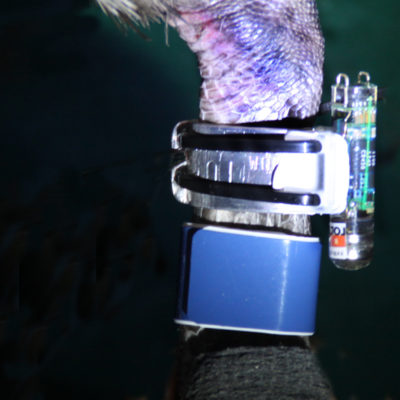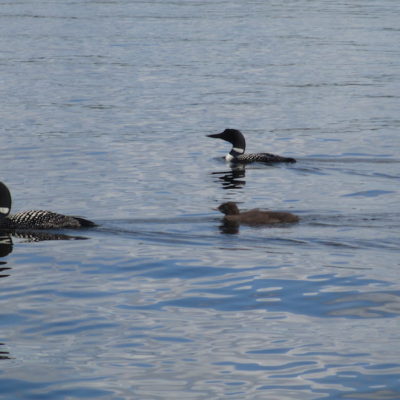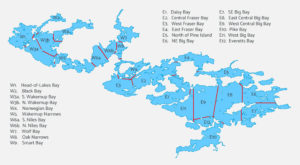Loon Stewardship on Lake Vermilion
Rebuilding Our Loon Population
In recent years, the loon population on Lake Vermilion – as measured by our annual loon count – has been below our 10-year average. We are concerned and have embarked on an aggressive multi-year project to restore our loon habitat, provide nest platforms in key areas, and reduce the use of lead fishing tackle. More initiatives are planned. As details come into focus, we’ll tell you about them here and explain how you can volunteer to help.
For information about how lead sinkers affect the loons and what you can do about it, click here.
Loon Nest Platforms
Loon nest platforms provide additional options for Vermilion’s nesting loons as their population recovers. If your lakeshore property provides suitable habitat and loons in your area have not had chicks recently, please consider “hosting” a loon nest platform. The nesting pair prefers a secluded location with low boat traffic and low exposure to boat wakes and wind-driven waves.
Plans for a nest platform can be found here. Vermilion Lake Association volunteers may be able to assist with construction. The lake association can also provide buoys and other signage to minimize inadvertent disturbances during nesting.
If interested, please contact Jill Korpela-Bontems, Lake Vermilion nest platform coordinator, for additional information.
Lake Vermilion Loon Migration
Kevin Kenow, Research Wildlife Biologist with the USGS, heads a team using implanted satellite transmitters to identify loon migration routes, staging areas, and wintering range. Beginning in July 2011, three Lake Vermilion loons were added to the study.
These three loons were tracked for several years until their transmitter batteries were exhausted. You can see their migration paths and monitor the migration of loons currently in the study at this USGS website.
Vermilion’s Annual Loon Count … 40 Years and Running
Lake Vermilion has always been known for its large population of loons. To lake residents and frequent visitors, the loon has been something special. One never tires of the haunting cries in the early morning or late evening hours, the sight of a loon cruising the open waters of the lake with his head below water looking for a meal, or the special scene of a loon chick — or maybe two — riding on a parent’s back to keep warm.
In the early 1980s, news of large loon die-offs off the coast of Florida had the Association worried. They could have been “our” loons. So in 1983 the Vermilion Lake Association (known then as the Sportsmen’s Club of Lake Vermilion) began keeping count of the loons on Lake Vermilion every summer.
The task was quite large: thousands of acres of water, many bays and islands, and a bird that wouldn’t sit still long enough to be counted only once. But if enough volunteers could be on the water on the same day, at the same time, an accurate count could be taken. Today, the Lake Vermilion Loon Count is the longest running, single lake count of common loons anywhere in the United States.
The Loon Counting Process
Thanks to the volunteers who currently traverse their territories so carefully each July. Since the beginning, 139 volunteers have participated. Of those, 61 have earned their 5-year patch. Quite a few have been involved for 25 years!
How Does One Count Loons?
Indeed, counting loons can be tricky. They don’t like to hold still. They spend extended periods underwater. And the chicks sometimes ride on the backs of the adults, appearing as only a strange bump under the feathers on the parent’s back. But practice helps, and the Vermilion Lake Association has been doing this since 1983.
The Association has divided Lake Vermilion into 23 territories. A team of 2 to 4 persons in a small boat slowly traverses its territory once. Each back-and-forth pass is about 100 yards from the last. All sightings are carefully verified through binoculars after a slow approach by boat, if necessary. The search usually takes 2 to 3 hours.
The search starts at the same time of day (9:00 a.m.), at the same time of year (mid-week during the 2nd week of July). This week and time of day is selected to provide good visibility, low competing boat traffic and to allow chicks to grow a bit to be more easily seen. If weather is a problem, the loon count is delayed a couple days.
Results are phoned in to a coordinator for each end of the lake. The numbers are relayed to the Loon Count Coordinator Claire Zwieg, who tallies the results for the Board of Directors and for the membership.
The “Loon Count” Volunteers and Their Territories
Thanks to the team of volunteers who currently traverse the territories pictured in the map.
If you’d like to join this team, please contact west-end coordinator Claire Zwieg or east-end coordinator Jill Korpela-Bontems. Alternate counters are often needed. And a territory opens up periodically
Lake Vermilion Loon Count 2023
By Joanne Bergman, VLA Volunteer
Adults, singles, and chicks
Throughout the lake from east to west, volunteers counted 156 adult loons, almost as many as last year’s 161. All boats reported a total of 156 adults and 29 chicks. The grand total is 185, a number close to last year’s 192.
Volunteers
Sixty-six observers spent 45.5 volunteer hours compiling the data on this, the 40th anniversary year of the Loon Count on Lake Vermilion.We owe a debt of gratitude to Mardy Jackson and Barb Shook, who initiated the Vermilion count in 1983. At the time, the count took place during the fourth week of July. According to the DNR, this is the forty-third summer of loon counting in Minnesota, and today loons and their chicks are tallied on 157 of our 10,000 lakes.
The DNR conducts two kinds of loon monitoring. Some lakes count every week, and others conduct one observation during a 10-day window, usually in early July.
Four groups were new to the count, owing to moves, passing, or retiring from loon counting. Facilitator Clair Zweig suggests that this may be “the only way new people can become part of the coveted volunteer position of loon counting.”
Comments from those reporting included, “It was a fun but windy day,” “Numbers on Big Bay were way down,” and “Lots of loons were spotted flying overhead.” One group saw a deer swimming, and several boats sighted banks of white swans and white pelicans, and all are unusual and fun to see.
Cormorants
The LVA asks observers to report an approximate number of cormorant sightings. Accuracy is difficult because a flight of the birds is often too large to count. This year’s cormorant total was 189, down from over 215 in 2022. Joanne and Warren Anderson saw their first and only cormorant ever in Black Bay, and observers along Wakemup and Niles counted just 10, all singles.
Identifying Leg Bands on Lake Vermilion Loons
 Biologists with the US Geological Survey banded eight adult and two juvenile common loons on Lake Vermilion in July 2011. All loons were banded either in Rice Bay or near Pine Island.
Biologists with the US Geological Survey banded eight adult and two juvenile common loons on Lake Vermilion in July 2011. All loons were banded either in Rice Bay or near Pine Island.
Six of the adults were marked with a silver leg band with a archival geolocator tag attached. The geolocator tag records location, temperature, and dive depth. Loons with a geolocator must be recaptured within five years to recover the data the tag has recorded. USGS scientists plan to return to Lake Vermilion during July 2012 to locate previously banded loons.
The three male birds also received a satellite transmitter, so an antenna may be visible.
To assist the USGS in recovering the geolocator data, please report sightings of banded loons to USGS Research Wildlife Biologist Kevin Kenow (kkenow@usgs.gov or 608-781-6278).
Leg Band Data for Lake Vermilion Loons
| Sat. Code | Date Banded | Where Banded | Age & Gender | Right Leg | Left Leg |
| Jul 2011 | E of Pine Island | Adult Unk | Red / Silver | Blue stripe / Green stripe | |
| Jul 2011 | E of Pine Island | Adult Unk | Green / Silver | Blue stripe only | |
| V4 | Jul 2011 | Rice Bay | Adult M | Red stripe / Silver | Green stripe / Silver with Geotag |
| Jul 2011 | Rice Bay | Adult F | Yellow / Silver | Blue stripe / Silver with Geotag | |
| V3 | Jul 2011 | N of Pine Island in Narrows Area | Adult M | Red stripe / Silver | White / Silver with Geotag |
| Jul 2011 | N of Pine Island in Narrows Area | Adult F | Green stripe / Silver | Red / Silver with Geotag | |
| V1 | Jul 2011 | N of Pine Island in Canfield Bay Area | Adult M | Yellow stripe / Silver | Green / Silver with Geotag |
| Jul 2011 | N of Pine Island in Canfield Bay Area | Adult F | Blue / Silver | Blue / Silver with Geotag |
Guidelines for Observing Loon Leg Bands
- Bands are most readily observed when loons preen. Loons will spend about 5 minutes preening (putting oil on their feathers) about every 30-60 minutes if they are comfortable with their surroundings. Once a preening bout ends, the birds will often return to foraging. Following a stressful event (disturbance by people, eagles, boats, intruding loons), loons will preen to reduce stress.
- On BOTH legs, note the colors and the order (upper/lower) they are in. All banded loons have at least one silver USFWS (US Fish and Wildlife Service) band in addition to the color bands. Some loons will have a single METAL/SILVER USFWS band with no color bands (infrequent) or only one color band on a leg. If you believe a loon is unbanded, you must see both legs completely to know with certainty there are no bands.




 Click to view large map.
Click to view large map.